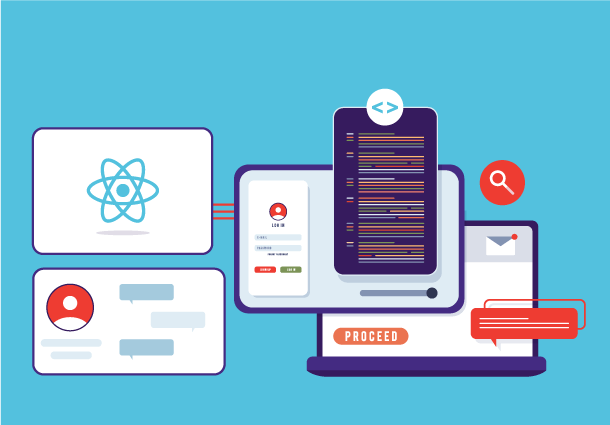Diving into the Ecosystem of Enhancing the User Experience with React.js
In the dynamic galaxy of the digital landscape of web development, user experience has become preeminent in enhancing any web page, and React.js is a powerful tool that helps to achieve the end goal. Additionally, this tool has gained boundless popularity in recent decades. It enables developers to build dynamic interface development and to create a seamless experience that enhances audience engagement and captivates user’s attention. One of the main key features of react.js is virtual DOM that allows React to furnish UI components efficiently and respond quickly to user interactions. Moreover, React.js offers a component-based architecture, which also allows developers to break down complex UIs into smaller, reusable components. This modularity streamlines development, promotes code reusability, and facilitates easier maintenance and updates. But are you still curious to know, why has React.js gained popularity in the market? And why do developers predestine React.js to create a website?
Moreover, React.js offers a component-based architecture, which also allows developers to break down complex UIs into smaller, reusable components. This modularity streamlines development, promotes code reusability, and facilitates easier maintenance and updates. But are you still curious to know, why has React.js gained popularity in the market? And why do developers predestine React.js to create a website?
In this article, we aim to dissect the reasons behind React.js’s meteoric rise in the realm of web development. We’ll meticulously examine the key features of react.js, its architecture, and also explore its benefits. And also to provide some evidence of React.js’s effectiveness, we’ll delve into real-time case studies that showcase its application in diverse industries and scenarios. These case studies will highlight how React.js has been used in crafting immersive user experiences, enhancing engagement, and driving business success. Without any further ado, let’s dive into to know more!
Deciphering the Enigmatic Realm of Dynamic User Interface Development
In today’s fast-paced digital world, user interface plays an important role in shaping user experiences. Dynamic user interface development is a process of creating an interactive interface that can provide more user engagement with a curated experience. Such an interface usually consists of features like animations, transitions, drag-and-drop functionality, and real-time updates. Dynamic User Interface equips users with more engaging and interactive experiences which leads to an increase in user satisfaction and retention. Besides the key concept of dynamic UI includes, DOM (document-object-model) manipulation, server-client communication, and so on.
Dynamic User Interface equips users with more engaging and interactive experiences which leads to an increase in user satisfaction and retention. Besides the key concept of dynamic UI includes, DOM (document-object-model) manipulation, server-client communication, and so on.
With DOM, developers can dynamically change the structure or the content of the webpage based on user inputs. Additionally, client-server communication plays a vital role in exchanging data between the user’s device and the server, facilitating seamless updates to the interface. To streamline the development process and build dynamic interfaces more efficiently, developers often rely on libraries like React.js, or Vue.js, which provide pre-built components and simplify complex tasks. Furthermore, a dynamic user interface serves better data visualization, enabling developers to cater data in an interactive form that can help users understand and analyze the information. For such an intuitive interface, ReactJs is a bridge that brings design to life and creates flawless interaction.
Presenting the Superheroic Power of React.JS in Crafting Dynamic User Interfaces Development
ReactJS is a Javascript library for curating fast, scalable, and interactive user interfaces. It was created by Facebook, which has evolved as a key component of contemporary front-end development. It is designed to simplify the process of designing interactive and responsive web applications by adding component-based architecture features and virtual DOM (Document Object Model) for efficient updates.
It’s an impressive tool to create user-friendly websites and applications. Furthermore, react.js also allows developers to create reusable user interface components and manage dynamic behavior efficiently. By implementing React.js to build websites and mobile applications, businesses can generate more revenue significantly.
Delving into the Quest of Vital Facets of React.JS to Build Dynamic Interactive User Interface
React.js offers several key features that contribute to its popularity significantly. One of the main key features of react.js is simplicity, facilitated by the use of a JSX file that makes an application run easily. Additionally react.js is simple to use and learn since it provides the reusability of code when required. Moreover, in react.js, components act like a building block for the web interface. There are two types of components in react.js- functional and class components. They are reusable UI modules that can be reused and combined effectively. This approach simplifies code organization and maintenance in large projects.
There are two types of components in react.js- functional and class components. They are reusable UI modules that can be reused and combined effectively. This approach simplifies code organization and maintenance in large projects.
Another key feature of react.js is that web applications work faster than those developed by front-end frameworks. This is certainly through a virtual DOM (Document Object Model) system. By selectively updating the necessary parts of the webpages, React.js ensures seamless and faster performance when compared to the web apps that are developed by front-end frameworks. React.js Virtual DOM also contributes to performance optimization. Furthermore, implementing DOM not only minimizes the direct manipulation of DOM and updates only the necessary parts but also significantly reduces the performance associated with user interface updates. Hence this feature makes react.js a top-notch choice for applications that need frequent changes in content.
Mastering the Interactivity of the Power of React.js in Crafting Dynamic User Interface
There are a plethora of reasons for using react.js for creating interactive user interfaces. The first comprehensive reason is that react.js virtual DOM ensures efficiency. Unlike any other DOM which updates the entire page when any changes occur, React’s Virtual DOM updates only the necessary parts of the web page when changes need to be made. This process allows React to identify and update only the certain element that needs to be changed, which results in faster rendering and a more responsive user experience.
With the component -based-architecture feature it allows developers to reuse UI elements. Developers can segment the codes and reuse them across different application parts. Furthermore, it can encapsulate specific functions and can be composed easily together. This reusable component allows efficient development leading to a more consistent and furbished user interface. Besides, with rect.js the JSX syntax extension allows developers to write HTML-like code within JavaScript. Mixing the fusion of HTML with Java it terminates the need for manual DOM manipulation. This approach results in cleaner and more readable codes. Also, it simplifies the creation of dynamic user interfaces, resulting in enhancing developers’ productivity and code readability.
Furthermore, react follows a unidirectional data flow which significantly means that data flows in a single direction- from parent to child component. If there are any minor changes in the child component, the structure of the “parent code” will not be disturbed. React.js boasts an extensive ecosystem that provides a pre-built component library, such as Material-UI, Semantic UI, etc. It also offers state management libraries like Redux and Mobx to streamline data handling, which contributes to smoother user experiences. Additionally, tools like React Router simplify the routing and navigation, while other tools like CSS-in-JS libraries help encapsulate style within individual components.
In addition, the react.js community provides invaluable support, and exchanges valuable insights, innovative techniques, and best practices to enhance their skills and create engaging and user-friendly interfaces. Also, it allows react.js developers to stay ahead of market trends with the latest developments through the community’s continuous discussions for creating engaging interfaces. Moreover, React.js prioritizes SEO-friendly features such as server-side rendering and optimized page load speed, ensuring better performance and visibility through search engines. By leveraging these aspects, developers can craft user interfaces that resonate with modern web users.
Revolutionizing Platform with Some Real-Time Studies for Modern Platforms by React.js
React.js’ versatility and efficiency make it a top-go-to-go choice for creating responsive and visually appealing web applications. From e-commerce platforms to social media, react.js enables developers to create real-time interfaces that can adapt to user interactions along with certain data changes.
Given below are some real-time uses from various industries for inheriting dynamic user interfaces:
Social Media Platform– Social media platforms like Twitter, Facebook, and Instagram use React.js to improve user interaction and experience. React.js features like Virtual DOM and component-based architecture allow for real-time updates, live notifications, and dynamic content feeds, providing a seamless experience for users.
Online Collaboration Tools– Collaboration software like Google Docs and Slack rely on React.js to create live interactive functions. React.js can manage simultaneous updates and share information between various users allowing for smooth cooperation on documents, tasks, and conversations.
Fintech Industry– The financial technology (fintech) sector relies heavily on React.js for developing dashboards and analytical tools. These dashboards offer real-time insights into market data and analytics, empowering users to monitor and manage their investments. React’s modular components simplify the creation of tailored and interactive data visualizations, enabling fintech experts to craft highly customizable dashboards and tools that meet the unique needs of their users.
Wrapping Up the Topic with Pattem Digital Innovation in React.js
In conclusion, react.js has gained popularity for building web applications, especially for creating dynamic user interfaces. React.js is efficient to use and consists of many useful features. Additionally, developers who use React.js can create applications that are easy to use, satisfying, and keep users engaged. The key feature of react.js is component-based architecture, virtual DOM, and unidirectional data flow, which allows developers to build highly responsive and seamless web applications.
It also allows developers to access the reusable components, streamline data management, and optimize performance. Furthermore, React.js boasts a vibrant community and a vast ecosystem of libraries and tools, providing invaluable support and resources for developers to stay at the forefront of web development trends. At Pattem Digital, we take pride in recognizing ourselves as the best react.js development agency and take the immense potential of React.js in shaping modern web experiences. Our team of skilled developers harnesses the power of React.js to create innovative solutions that meet the unique needs of our clients across diverse industries. By leveraging React.js, we ensure that our clients.





